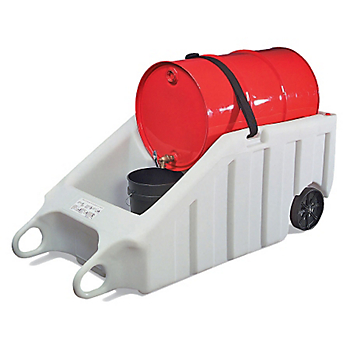
PIG® Mobile Dispensing Dolly
DRM664
Write a Review
For 210 ltr. Drums, 272 kg Load Capacity, 1 each
As Low As £740.05 (Ex. VAT)
Do-it-all unit transports 210-litre drums, tilts for dispensing and provides secondary containment in a closed sump.
Read More
PRICING (Based on quantity)
| 1 - 2 | 3 + |
|---|---|
|
1
- 2 £779.00 (Ex. VAT) |
3
+
£740.05 (Ex. VAT) Best Buy |
| Best Buy |

Description & Specifications
Do-it-all unit transports 210-litre drums, tilts for dispensing and provides secondary containment in a closed sump.
- Versatile unit transports 210-litre drums, tilts for dispensing and provides secondary containment
- Closed sump lets you move unit without contained liquids splashing out
- Rugged polyethylene with UV inhibitors for indoor and outdoor use
- Roomy 35cmH x 61cmW x 41cmL well accommodates 19-litre buckets for refilling
- Sump capacity helps you meet containment regs
- Ergonomically designed to minimise back strain and fatigue
- 25cm solid rubber wheels are excellent for use on concrete or asphalt outdoors
| Use With | 210 ltr. Drums |
| Colour | White |
| Dimensions | 81cm W x 175cm L x 67cm H |
| Load Capacity UDL | 272 kg |
| Sump Capacity | 265 L |
| Lockable Wheels | Wheels Not Lockable |
| Sold as | 1 each |
| Weight | 46.3 kg |
| # per Pallet | 1 |
| Composition | LLDPE Hard rubber wheels Stainless steel axle Nylon security strap |
| Wheels | 25cm Wheels |
Reviews
Based on 0 review(s)
Additional Information
- Chemical Compatibility for PIG LDPE Products
-
The Control of Pollution (Oil Storage) Regulations (Northern Ireland) 2010
The Regulations apply to above ground oil storage facilities on industrial, commercial and institutional residential sites. They also extend to companies who refine or distribute oil. The Regulations set minimum design standards for new and existing above ground oil storage facilities, codifying existing good practice to ensure that above ground oil storage facilities are adequately constructed. A key requirement of the Regulations is for the storage container to have a secondary containment system (a bund, which is an outer wall or enclosure designed to contain the contents of an inner tank, or, a drip tray) to ensure that any leaking or spilt oil is contained and does not enter the aquatic environment. -
The Control of Pollution (Oil Storage)(England) Regulations 2001
This regulation applies to any container with a storage capacity of over 200 litres, and applies to any industrial, commercial or institutional site, e.g. factories, shops, offices, hotels, schools, public sector buildings and hospitals. All types of oil except waste oil are included. A bund or catchpit has to form a container around the tank capable of holding 110% of the contents of the oil stored or 25% of the total volume, whichever is greater. This is known as secondary containment. -
The Manual Handling Operations Regulations 1992
The Manual Handling Operations Regulations 1992 apply where loads are moved or supported by human effort at work. 'Manual handling operations' include lifting, putting down, pushing and carrying by one or more workers; and manipulating loads by indirect means such as levers or ropes. The regulations do not apply to using machinery controls or supporting tools in operation. -
The Water Environment (Oil Storage) (Scotland) Regulations 2006
This regulation applies to any container with a storage capacity of over 200 litres. It affects all premises, including land and mobile plant, as well as private dwellings. "Oil" means any kind of oil and includes petrol, diesel, waste and vegetable and plant oil, but does not include bitumen. The storage container, whether indoors or outdoors, must be situated within a secondary containment system capable of holding 110% of the contents of the oil store or 25% of the total volume (whichever is greater). -
The Water Resources (Control of Pollution) (Oil Storage) (Wales) Regulations 2016
The Regulations apply to any kind of oil, including petrol, diesel, kerosene, lubricating oil (both mineral and synthetic), waste oil, vegetable and plant oil, and apply to any kind of container which has a capacity of greater than 200 litres which is being used to store oil above ground, whether inside or outside a building. This includes fixed tanks, intermediate bulk containers (IBCs), drums (oil drums or similar containers used for storing oil) or mobile bowsers. The Regulations will come into force in 3 stages - Tanks installed after 15 March 2016 will have to comply with the Regulations from the date they are installed; Existing tanks at significant risk (i.e. facilities that are located within 10 metres of any surface water or wetland, or 50 metres of a borehole or well), will have to comply within 2 years (i.e. by 15 March 2018); Existing tanks not at significant risk will have to comply within 4 years (i.e. by 15 March 2020). The secondary containment system must contain at least 110% of the maximum contents of the oil container, or at least 25% of the total storage capacity if multiple containers are stored, whichever is the greater.
Disclaimers
Flammables Notice
If using this product with flammable liquids, please consider the regulations that apply to storage and handling of flammable liquids and the safety of this application, specifically flammable vapours, static discharge and heat sources. For further assistance, please call Technical Services.












